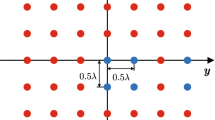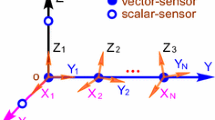Abstract
In this paper, we propose an extended aperture direction-of-arrival (DOA) estimation algorithm using a coprime acoustic vector sensor array. Each acoustic vector sensor consists of one pressure sensor and one uniaxial velocity sensor, collocated in a single point in space. By full utilization of both pressure and particle-velocity information in the acoustic wavefield, the whole coarray output is shown to be treated as four pressure–velocity (p–v) components. In this way, array interpolation and Toeplitz matrix reconstruction are performed on each of the four p–v components to exploit the entire coarray aperture. After interpolation, DOA estimates are derived in closed form using the interpolated coarray data. The proposed algorithm allows the inter-sensor spacing of the interpolated coarray to be significantly greater than half a wavelength, thereby achieving aperture extension without needing extra sensors. Moreover, it enables provide the unambiguous DOA estimates with high accuracy, despite the phase aliasing caused by aperture extension. All these advantages are not offered by the existing coprime array DOA estimation algorithms. Finally, computer simulations are carried out to verify the superiority of the proposed algorithm.



Similar content being viewed by others
Data Availability Statement
The data used to support the findings of this study are available from the corresponding author upon request.
References
M. Aktas, H. Ozkan, Acoustic direction finding using single acoustic vector sensor under high reverberation. Digital Signal Process. 75, 56–70 (2018)
M.K. Awad, K.T. Wong, Recursive least-squares source tracking using one acoustic vector sensor. IEEE Trans. Aerosp. Electron. Syst. 48(4), 3073–3083 (2012)
Z. Chen, C. Fan, X. Huang, Virtual array interpolation for coprime arrays: a signal reconstruction perspective. Electron. Lett. 56(22), 1213–1215 (2020)
B.A. Cray, A.H. Nuttall, Directivity factors for linear arrays of velocity sensors. J. Acoust. Soc. Am. 110(1), 324–331 (2001)
M. Fu, Z. Zheng, W.-Q. Wang, H.C. So, Coarray interpolation for DOA estimation using coprime EMVS array. IEEE Signal Process. Lett. 28, 48–552 (2021)
A. Gunes, M.B. Guldogan, Joint underwater target detection and tracking with the Bernoulli filter using an acoustic vector sensor. Digital Signal Process. 48, 246–258 (2016)
J. He, L. Li, T. Shu, Sparse nested arrays with spatially spread orthogonal dipoles: high accuracy passive direction finding with less mutual coupling. IEEE Trans. Aerosp. Electron. Syst. 57(4), 2337–2345 (2021)
J. He, L. Li, T. Shu, Sparse nested arrays with spatially spread square acoustic vector sensors for high accuracy underdetermined direction finding. IEEE Trans. Aerosp. Electron. Syst. 57(4), 2324–2336 (2021)
J. He, Z. Liu, Efficient underwater two-dimensional coherent source localization with linear vector hydrophone array. Signal Process. 89, 1715–1722 (2009)
J. He, Y. Wang, T. Shu, T. -K. Truong, Polarization, angle, and delay estimation For Tri-polarized systems in multipath environments. IEEE Trans. Wireless Commun. https://doi.org/10.1109/TWC.2022.3143834
J. He, Z. Zhang, T. Shu, W. Yu, Direction finding of multiple partially polarized signals with a nested cross-diople array. IEEE Antennas Wirel. Propag. Lett. 16, 1679–1682 (2017)
J. He, Z. Zhang, C. Gu, T. Shu, W. Yu, Cumulant-based 2-D direction estimation using an acoustic vector sensor array. IEEE Trans. Aerosp. Electron. Syst. 56(2), 956–971 (2020)
S.M. Hosseini, M.A. Sebt, Array interpolation using covariance matrix completion of minimum-size virtual array. IEEE Signal Process. Lett. 24(7), 1063–1067 (2017)
F. Jacobsen, V. Jaud, J. Acoust, A note on the calibration of pressure-velocity sound intensity probes. J. Acoust. Soc. Am. 120(2), 830–837 (2006)
S. Liu, Z. Mao, Y.D. Zhang, Y. Huang, Rank minimization-based toeplitz reconstruction for DoA estimation using coprime array. IEEE Commun. Lett. 25(7), 2265–2269 (2021)
C.L. Liu, P.P. Vaidyanathan, Remarks on the spatial smoothing step in coarray MUSIC. IEEE Signal Process. Lett. 22(9), 1438–1442 (2015)
C. Liu, P. P. Vaidyanathan, P. Pal, Coprime coarray interpolation for DOA estimation via nuclear norm minimization. in 2016 IEEE International Symposium on Circuits and Systems. 2639–2642 (2016)
M.E. Lockwood, D.L. Jones, Beamformer performance with acoustic vector sensor in air. J. Acoust. Soc. Am. 119(1), 608–619 (2005)
L. Ma, T.A. Gulliver, A. Zhao, C. Ge, X. Bi, Underwater broadband source detection using an acoustic vector sensor with an adaptive passive matched filter. Appl. Acoust. 148, 162–174 (2019)
P. Ma, J. Li, F. Xu, X. Zhang, Hole-free coprime array for DOA estimation: augmented uniform co-array. IEEE Signal Process. Lett. 28, 36–40 (2021)
A. Nehorai, E. Paldi, Vector-sensor array processing for electromagnetic source localization. IEEE Trans. Signal Process. 42(2), 376–398 (1994)
C. Niu, Y. Zhang, J. Guo, Interlaced double-precision 2-D angle estimation algorithm using L-shaped nested arrays. IEEE Signal Process. Lett. 23(4), 522–526 (2016)
P. Pal, P.P. Vaidyanathan, Coprime sampling and the MUSIC algorithm, in Proceedings of Digital Signal Process. Workshop IEEE Signal Processing Education Workshop, (Sedona, AZ, USA, 2011), pp. 289–294
P. Pal, P.P. Vaidyanathan, Nested array: a novel approach to array processing with enhanced degrees of freedom. IEEE Trans. Signal Process. 58(8), 4167–4181 (2010)
P. Palanisamy, N. Kalyanasundaram, P. M. Swetha, Two-dimensional DOA estimation of coherent signals using acoustic vector sensor array. Signal Process. 92(1), 19–28 (2012)
Y. Pan, G.Q. Luo, Efficient direction-of-arrival estimation via annihilating-based denoising with coprime array. Signal Process. 184, 108061 (2021)
H. Qiao, P. Pal, Unified analysis of co-array interpolation for direction-of-arrival estimation. in Proceedings of IEEE International Conference on Acoustics, Speech, and Signal Processing. (New Orleans, LA, USA, 2017). pp. 3056–3060
R. Roy, T. Kailath, ESPRIT-estimation of signal parameters via rotational invariance techniques. IEEE Trans. Acoust. Speech, Signal Process. 37(7), 984–995 (1989)
R.O. Schmidt, Multiple emitter location and signal parameter estimation. IEEE Trans. Antennas Propag. 34, 276–280 (1986)
V. Shchurov, Vector Acoustics of the Ocean (Dalnauka, Vladivostoc, Russia, 2006)
J. Shi, F. Wen, T. Liu, Nested MIMO radar: coarrays, tensor modeling, and angle estimation. IEEE Trans. Aerosp. Electron. Syst. 57(1), 573–585 (2021)
T. Shu, J. He, V. Dakulagi, 3-D near-field source localization using a spatially spread acoustic vector sensor. IEEE Trans. Aerosp. Electron. Syst. 58(1), 180–188 (2022)
T. Shu, L. Li, J. He, Near-field source localization with two-level nested arrays. IEEE Commun. Lett. 24(11), 2488–2492 (2020)
G.L. D’Spain, J.C. Luby, G.R. Wilson, R.A. Gramann, Vector sensors and vector sensor line arrays: comments on optimal array gain and detection. J. Acoust. Soc. Am. 120(1), 171–185 (2006)
X. Wang, Z. Chen, S. Ren, S. Cao, DOA estimation based on the difference and sum coarray for coprime arrays. Digital Signal Process. 69, 22–31 (2017)
K.T. Wong, H. Chu, Beam patterns of an underwater acoustic vector hydrophone located away from any reflecting boundary. IEEE J. Ocean. Eng. 27(3), 628–637 (2002)
K.T. Wong, M.D. Zoltowski, Extended-aperture underwater acoustic multi-source azimuth/elevation direction-finding using uniformly but sparsely spaced vector hydrophones. IEEE J. Ocean. Eng. 22(4), 659–672 (1997)
K.T. Wong, M.D. Zoltowski, Root-MUSIC-based azimuth-elevation angle-of-arrival estimation with uniformly spaced but arbitrarily oriented velocity hydrophones. IEEE Trans. Signal Process. 47(12), 3250–3260 (1999)
K. Wu, V.G. Reju, A.W.H. Khong, Multisource DOA estimation in a reverberant environment using a single acoustic vector sensor. IEEE Trans. Audio, Speech, Lang. Process. 26(10), 1848–1859 (2018)
C. Wen, G. Shi, X. Xie, Estimation of directions of arrival of multiple distributed sources for nested array. Signal Process. 130, 315–322 (2017)
F. Wen, J. Shi, Z. Zhang, Generalized spatial smoothing in bistatic EMVS-MIMO radar. Signal Process. 193, 108406 (2022)
S. K. Yadav, N. V. George, Fast direction-of-arrival estimation via coarray interpolation based on truncated nuclear norm regularization. IEEE Trans. Circuits Syst. II, Exp. Briefs 68(4), 1522–1526 (2021)
W. Zheng, X. Zhang, P. Gong, H. Zhai, DOA estimation for coprime linear arrays: an ambiguity-free method involving full DOFs. IEEE Commun. Lett. 22(3), 562–565 (2018)
Z. Zheng, Y. Huang, W.-Q. Wang, H.C. So, Direction-of-arrival estimation of coherent signals via coprime array interpolation. IEEE Signal Process. Lett. 27, 585–589 (2020)
X. Zhong, A.B. Premkumar, A.S. Madhukumar, Particle filtering and posterior Cramér–Rao bound for 2-D direction of arrival tracking using an acoustic vector sensorl. IEEE Sensors J. 12(2), 363–377 (2012)
X. Zhong, A.B. Premkumar, Particle filtering approaches for multiple acoustic source detection and 2-D direction of arrival estimation using a single acoustic vector sensor. IEEE Trans. Signal Process. 60(9), 4719–4733 (2012)
C. Zhou, Y. Gu, Y.D. Zhang, Z. Shi, T. Jin, X. Wu, Compressive sensing-based coprime array direction-of-arrival estimation. IET Commun. 11(11), 1719–1724 (2017)
C. Zhou, Y. Gu, Z. Shi, Y.D. Zhang, Off-grid direction-of-arrival estimation using coprime array interpolation. IEEE Signal Process. Lett. 25(11), 1710–1714 (2018)
C. Zhou, Y. Gu, X. Fan, Z. Shi, G. Mao, Y.D. Zhang, Direction-of-arrival estimation for coprime array via virtual array interpolation. IEEE Trans. Signal Process. 66(22), 5956–5971 (2018)
Funding
The article was funded by National Natural Science Foundation of China in the Grant No.(42075134).
Author information
Authors and Affiliations
Corresponding author
Additional information
Publisher's Note
Springer Nature remains neutral with regard to jurisdictional claims in published maps and institutional affiliations.
Rights and permissions
About this article
Cite this article
Ling, X., Zhu, H. Extended Aperture DOA Estimation Using Coprime Arrays via Coarray Interpolation. Circuits Syst Signal Process 41, 6222–6237 (2022). https://doi.org/10.1007/s00034-022-02078-4
Received:
Revised:
Accepted:
Published:
Issue Date:
DOI: https://doi.org/10.1007/s00034-022-02078-4




